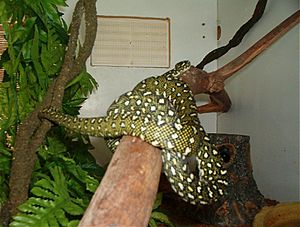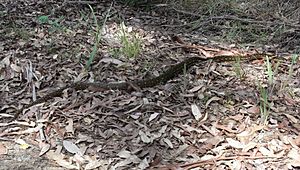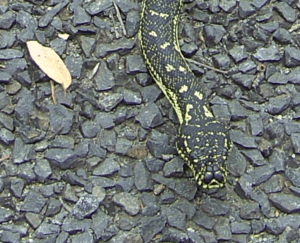Morelia spilota spilota facts for kids
Quick facts for kids Morelia spilota spilota |
|
|---|---|
 |
|
| Conservation status | |
| Scientific classification |
|
| Kingdom: | Animalia |
| Phylum: | Chordata |
| Class: | Reptilia |
| Order: | Squamata |
| Suborder: | Serpentes |
| Family: | Pythonidae |
| Genus: | Morelia |
| Species: | |
| Subspecies: |
M. s. spilota
|
| Trinomial name | |
| Morelia spilota spilota (Lacépède, 1804)
|
|
| Synonyms | |
|
|
The diamond python (Morelia spilota spilota) is a type of carpet python. It is a medium to large snake. You can find it in the coastal areas and nearby mountains of southeastern Australia. This snake is special because it lives further south than any other python in the world. It also lives in higher places than any other Australian python species.
Contents
What Diamond Pythons Look Like
Diamond pythons have different colors and patterns. They are usually dark olive or black. Most of their back scales have a yellow or cream spot in the middle. This is why they are called "spotted" (spilota).
Along their body and tail, they have groups of yellow or cream scales. These groups form "rosettes" that look a bit like diamonds. This is where their common name, "diamond python," comes from. Their belly is white, cream, or yellowish. It often has black spots.
Most adult diamond pythons are about 2 meters (6.5 feet) long. Some can grow up to 3 meters (10 feet). Very rarely, some have been recorded at 4 meters (13 feet) long.
Diamond Python Reproduction
Diamond pythons lay eggs. This means they are oviparous. A female snake usually lays about 25 eggs in a clutch. She can lay up to 54 eggs.
The mother snake protects her eggs. She coils around them and shivers to keep them warm. She does not leave her eggs to eat while they are developing. She only leaves briefly to warm herself in the sun. Then she returns to her eggs. Once the baby snakes hatch, the mother does not care for them anymore.
Young diamond pythons look similar to other carpet python babies. They become more distinct as they grow older. Hatchlings are usually browner than the black color of adult snakes.
Where Diamond Pythons Live
The diamond python lives in the southern coastal parts of New South Wales and Victoria. They live in many different places. These include heaths, woodlands, forests, and even city areas. They are known to live in the roofs of suburban homes. There, they eat mice and rats.
In Victoria, there are not many diamond pythons. They are considered rare and are threatened because their habitat is shrinking. In New South Wales, they sometimes naturally breed with another type of carpet python, M. s. mcdowelli. This happens in the northern parts of the diamond python's range.
Diamond pythons can be found in higher places than any other python. For example, they live in the eastern Gippsland region and the Blue Mountains. They are usually found on the eastern side of the Great Dividing Range. They can also be found in the ranges and sometimes far from the coast. They live further south than any other python.
Diamond Python Behavior
Diamond pythons are usually calm and do not often bite. This python is an ambush predator. This means it waits for its food to come by. They have large areas where they live, and these areas often overlap.
They move around their territories depending on the season. In warmer months, they find good hiding spots. In winter, they become less active and rest. Female pythons can have territories up to 50 hectares (124 acres). Males might have areas almost twice as large.
Diamond pythons are often active during the day and on warm nights. However, they spend most of their time waiting for prey. They usually stay in one spot for up to two weeks. Then they move about 100 meters (330 feet) away.
M. s. spilota kills its food by squeezing and suffocating it. They eat lizards, birds, and mammals like possums. They are not dangerous to humans. But they can bite if they are bothered a lot. They might leave teeth in the wound.
Diamond Pythons as Pets
Many people around the world keep diamond pythons as pets. It is against the law to catch wild ones. However, they are successfully bred in captivity. This helps meet the demand for this popular reptile.
Pet diamond pythons are usually fed rodents. They are kept in special environments like a vivarium. Pythons bred and raised in captivity become quite tame. They can be handled gently and make good pets. They are one of the few snakes that are usually calm and not defensive when they hatch from their eggs.
See also
 In Spanish: Pitón diamantina para niños
In Spanish: Pitón diamantina para niños




